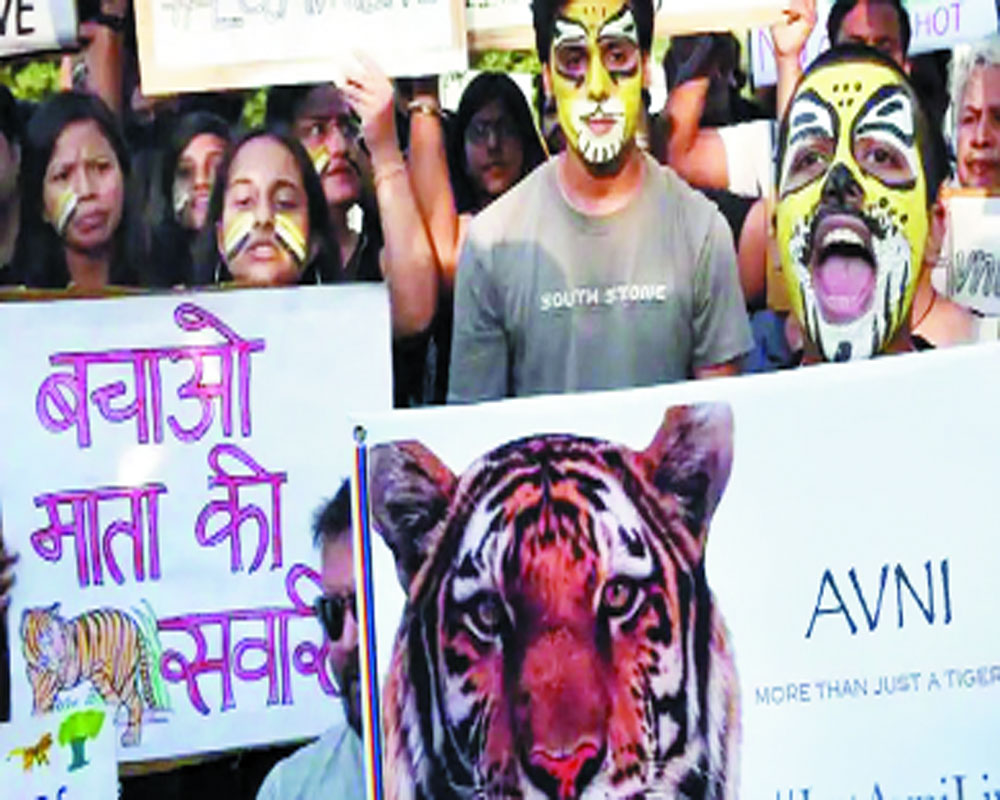Even though the density of tigers has seen a marked increase in the country, what’s worrying is that their territory is getting smaller.
While the premeditated killing of the “man-eating” tigress Avni in Maharashtra has conservationists and the state forest department grid-locked in arguments over whether it was ethical or not, the real issue that needs urgent attention is the transmuted nature of man-animal conflict in future wildlife management. Nothing brought this home more chillingly than infiltrators in the Dudhwa buffer zone brutally running a tractor over another tigress who had mauled a man crossing her path on Monday. Like her, the six-year-old Avni didn’t become a man-eater because she was running out of prey base, nor did she drag people stealthily out of the village nearest the Yavatmal forest. In fact, she was seen crossing a farm the day she was shot. Her kills were essentially to protect her young cubs and a battle won for survival on the fringes.
As tiger density has increased in the country, there has been a considerable shrinkage in the territory that each big cat loves to lord over, forcing them to often tussle between themselves through violent pride fights. Avni was one such young mother pushed to the fringes, ferociously protective of her cubs who became easy targets for aggressive males. And with human depredations eroding corridors to other forest tracts and even buffer zones, there was no possibility of her safe passage to a newer territory. Trapped in a wedge between human encroachment and her shrinking range, she developed a guerrilla-style hideout strategy to live rather than to hunt, imparting it to her cubs too. Which is why for all the technologically-aided snooping of drones, camera traps and sensors, she has been evading the eagle eye for almost two years, killing 13 people who crossed her line of restraint. And her traumatised cubs have bled into the recesses of the forest, knowing their mother won’t be back and humans wouldn’t be any less punishing.
Till this territorial battle and angst is neutralised through safe havens, there will forever be controversy about which life is more important, human or animal, and evolutionary aberrations of changed species behaviour. No tiger had attacked a villager in Dudhwa over the last decade but the dead tigress like Avni did.
This doesn’t mean that we can in any which way justify the violations of the state forest department. Why did it hire a banned sharpshooter to kill Avni and not seek help of professional dart-shooting teams? Why did it not follow the tranquiliser shot protocol and kill the tiger directly, that too at night when such tracking isn’t allowed? If the shooter took out the gun in self-defence after a tranquiliser shot failed to work, as argued by the forest department, how come the tranquiliser dose was not adequate? Why was the Supreme Court-mandated protocol for eliminating Avni under duress not complied with? And most importantly, why were no attempts made to find and rehabilitate her cubs before the kill, knowing full well that they could die with poor hunting skills in their mother’s absence? In the process, we have lost three young, strong tigers.
The short-sighted solution to getting rid of man-eaters won’t work till we address why they become so and take preventive measures. Agreed relocation may not be entirely successful — some tigers finding it difficult to flourish in another ecosystem and claim it as their own — but it is a start. The tiger has returned to Sariska through such sustained and graded efforts. Similarly, transit corridors to other reserves, allowing the tigers natural right of way, should be prioritised and it’s a well-known fact that the State Government has allowed a corporate to set up a cement plant near Yavatmal forest, threatening breeding habitat. And though foresters have traditionally been conservators too, they need to be apprised of newer vigil systems given the changing animal behaviour. Both man and animal are equal captives of a changed eco-system and are, therefore, posing a fresh challenge.
Writer: Pioneer
Courtesy: The Pioneer








 OpinionExpress.In
OpinionExpress.In















Comments (0)